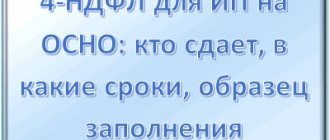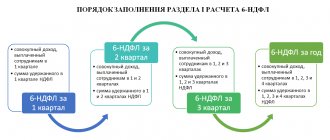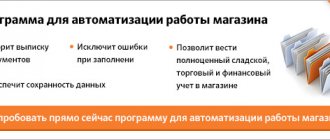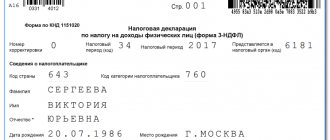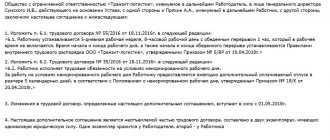Is it necessary to submit zero 3-NDFL for individual entrepreneurs?
Individual entrepreneurs are required to submit a 3-NDFL declaration in 2 cases:
- as individuals - for ordinary income not related to business; whereas economic activity is carried out under a special tax regime;
- as entrepreneurs who are taxed under the general taxation system, i.e. OSNO.
An individual entrepreneur working for OSNO is a rarity, since most small businesses prefer special regimes, because instead of 3 taxes, one is paid - a special one, replacing personal income tax, VAT and property tax. However, in practice there are also combinations of modes - special and general, when an individual entrepreneur keeps separate records of income and income of the business share in a special mode and shares in a general one. In this case, you also need to pay personal income tax in the part that falls under the OSNO.
A common reason for using OSNO is VAT, because large suppliers work on a system for refunding this tax, and to cooperate with them you also need to be a VAT payer. But is it necessary to submit 3-NDFL for an individual entrepreneur without income? For example, during the calendar year, the entrepreneur did not conduct that part of the activity that fell under the OSNO, or incurred expenses and had no income?
According to clause 2 of Article 80 of the Tax Code of the Russian Federation, if a business entity does not operate, being a payer of personal income tax, VAT and property taxes, and there is no movement of finances in its accounts and cash registers, and there are no objects of taxation in the tax period, then it submits one simplified declaration instead different.
Important! The simplified declaration from clause 2 of Article 80 of the Tax Code of the Russian Federation and the zero declaration for 3-NDFL are different reports submitted in different situations. In the first case, the person does not have any business at all, despite the fact that the individual entrepreneur remains active, and in the second, there is no taxable income: there were expenses or the individual entrepreneur took advantage of deductions that reduced the base to zero.
Zero form 3-NDFL for individual entrepreneurs for 2020 is submitted according to the general rules:
- deadline - until April 30, deadline - the first working day of May;
- you need to use the current version - you can download the latest approved form here ;
- the report can be completed in paper and computer format;
- You can submit the form, or maybe your representative who has a notarized power of attorney; You can also submit documents through the portal “State and MFC; you can send the kit by mail - with a list of the contents and certified copies of all documents;
- the electronic format can be submitted online or brought on external media to the Federal Tax Service;
- when using to fill out the program, it is also important to use the version corresponding to the year for which you are reporting; So, for 2020 this version is valid;
- Violation of the deadline for submitting reports entails the collection of a fine in the amount approved by Article 119 of the Tax Code of the Russian Federation, as well as the accrual of penalties for each missed day.
https://youtu.be/1eMZ8LxK93E
Example of filling out 3-NDFL for individual entrepreneurs
As a rule, it is enough for an individual entrepreneur to fill out the following sheets of 3-NDFL:
- Title;
- Section 1 – personal income tax to be paid or refunded;
- 2nd section – calculation of the base and the tax itself, broken down by rates;
- B – income from the activities of individual entrepreneurs.
The remaining sheets of 3-NDFL must be filled out if the individual entrepreneur had income, deductions and rates that fit these sheets in the past year.
It is more convenient to fill out 3-NDFL, starting with sheet B, then carry out the calculation in the 2nd section, then reflect the calculated data in the 1st section and enter the necessary information about yourself and the number of completed pages on the title page.
Sheet B
A separate sheet B should be generated for each type of activity.
Line by line design:
| Field number | Reflected indicator |
| For each type of activity performed, fill in: | |
| 1.1 | Set to “1” for individual entrepreneurs |
| 1.2 | OKVED code |
| 2.1 | The amount of annual income for the specified activity |
| 2.2 | The amount of actual expenses that are taken into account as part of the professional deduction (these expenses, if documented, reduce the basis for calculating personal income tax). This value is specified in 4 subparagraphs, depending on the type of costs. |
| 2.3 | To be completed if the individual entrepreneur cannot confirm with documents the expenses from clause 2.2 and decides to accept a standard equal to 20% of the income from clause 2.1 as a professional deduction. An entrepreneur should choose what he will accept as a deduction – documented actual costs or a standard of 20% of income. |
| After reflecting data on all activities, indicators on income and deductions are summarized on the last page of sheet B: | |
| 3.1 | The sum of indicators of all lines under clause 2.1 |
| 3.2 | Total amount of deduction |
| 3.3 | The amount of advances calculated by the tax office and presented in the form of tax notices at the end of each quarter. |
| 3.4 | The total amount of actually transferred advances must be confirmed by the availability of appropriate payment receipts. |
2nd section
After reflecting information on income for all types of activities, you should calculate the base and tax payable in the 2nd section.
For each personal income tax rate, the calculation is carried out on a separate sheet.
Line by line completion for each rate specified in field 001:
| Field number | Reflected indicator |
| 1 | The total amount of income for the year from clause 3.1 of sheet B (except for dividends) |
| 2 | Filled out if there are non-taxable transactions (from sheet D). |
| 3 | The difference between the indicators of the 1st and 2nd points. |
| 4 | The total amount of the deduction from clause 3.2 of sheet B |
| 5 | Expenses for operations from sheets Z and I, including dividends in clause 5.1 |
| 6 | Base for calculating personal income tax (difference of income and deductions) |
| 7 | Personal income tax payable equal to the product of the rate indicated in field 001 and the base from clause 6. |
| 10 | Actual advances listed by the entrepreneur from clause 3.4, sheet B |
| 13 | Tax payable taking into account personal income tax from clause 7 and the listed advances from clause 10. |
| 13.3 | The indicator from paragraph 13 is repeated |
| 14 | Personal income tax is refundable if the personal income tax payable is less than the payments paid in advance. |
1st section
The calculations made allow you to fill in data on the amounts to be paid or returned from the budget.
Line by line filling
| Field number | Reflected indicator |
| 010 | The operation that an individual entrepreneur must perform on the basis of this declaration:
|
| 020 | The corresponding BCC for which payment to the budget must be made |
| 030 | OKTMO of the territorial location of the individual entrepreneur |
| 040 | Amount to be transferred |
| 050 | Amount to be refunded |
Title page
The last to be drawn up is the first sheet of 3-NDFL, in which the following information is entered:
- Adjustment No. – 000 at initial feed;
- Period – “34” and the year for which the report is provided;
- Country code – 643 for the Russian Federation;
- Payer category – 720 for individual entrepreneurs;
- Full name;
- Birth information;
- Information about the identification document, if it is a passport, then its code is 21;
- Payer status – tax residents of the Russian Federation put “1”;
- The residence address of the entrepreneur, confirmed by documents;
- Number of completed 3-NDFL sheets;
- Information about the person submitting the declaration, if it is the individual entrepreneur himself, then it is put in the section on reliability “1”, there is no need to write the full name again, if it is a representative, then it is put “2”, his full name and details of the power of attorney issued by the individual entrepreneur are indicated.
Which zero 3-NDFL sheets must be submitted for individual entrepreneurs?
If you have questions or need help, please call Free Federal Legal Advice.
- The call throughout Russia is free 8 800 350-94-43
In the new form, the names of all sheets except the first three have been changed. So, instead of the usual sheet B, entrepreneurs now attach sheet “Appendix 3”.
As a result, the required zero 3-NDFL sheets for individual entrepreneurs:
- Title;
- Section 1 - the structure has changed;
- Section 2 - unchanged;
- Appendix 3 - on business income.
Important! If you are submitting a paper form, you will have to independently assemble the declaration in the correct sequence of sheets, number them and the sheets of the attached copies of documents, and indicate the total number of pages of the entire package on the title page. The declaration is not stitched.
In the program and in the online service, the sequence of sheets and numbering are done automatically.
Important!
If you had income or deductions for the past year that are not related to running a business, they are also added to the same declaration on the appropriate sheets.
What is a zero declaration 3-NDFL
Beginning businessmen are most often faced with filing a zero declaration. It is when starting a business that there is no income in the first months. In addition, not all registered individual entrepreneurs start working immediately, so initially there is no profit. A situation where there is no income in the reporting year can occur if an individual entrepreneur suspends its activities for some reason.
Of course, when there is no income, there is no need to talk about paying taxes. Then the question arises: why file a tax return at all? The thing is that even when you don't have any income on your report and you don't pay taxes, the report still needs to be filed. If you don't do this, you will be breaking the law.
If you are a financial entity, then in any case you will be a taxpayer. Hence the mandatory obligation to file a declaration. In the end, thanks to the tax return, the auditing service finds out that you did not have any income. In cases where zero 3-NDFL was not filed, then you will face fines.
Also, a zero declaration is required in the case when individuals report. For example, you are selling real estate or other property. However, for a number of reasons you do not need to pay taxes. Even in this case, you will have to report to the Federal Tax Service.
Which sheets of the 3-NDFL zero declaration should be submitted when closing an individual entrepreneur?
If an entrepreneur ceases operations and submits an application to the Federal Tax Service to close the business, he is obliged to submit reports to the tax authorities - for that part of the period in which he managed to work since the beginning of the calendar year or reporting period.
In particular, it is necessary to submit a 3-NDFL declaration - within 5 days from the date of registration of the closure of business activities. The report form is normal, it indicates the tax period “34” (calendar year), it consists of the same sections and sheets that need to be filled out in the zero 3-NDFL for individual entrepreneurs when continuing activities, but in the absence of income.
In addition, documents on other taxes are submitted - VAT, insurance premiums, and if you had employees, then you must submit a large list of personalized accounting forms.
Is it necessary to submit a 3-NDFL declaration for individual entrepreneurs to OSNO?
The general taxation system requires mandatory payment of personal income tax for all individual entrepreneurs using this regime. If the individual entrepreneur has recently switched to it, then after the first monthly income a 4-NDFL certificate must be submitted within 5 days, and in all other cases it is necessary to submit a 3-NDFL declaration once a year, taking into account all other personal income of the entrepreneur.
Important! 3-NDFL for individual entrepreneurs on OSNO is necessary even if there is no reporting for the year. In this case, you will need to submit a declaration with zero indicators.
How to fill out zero 3-NDFL for individual entrepreneurs
When filling out a paper form, follow these guidelines:
- all reports are checked by automated scanning systems, so it is important to comply with graphical filling standards;
- you need to use a black or blue pen;
- write strictly in printed and capital letters and numbers;
- manually, the columns are filled in from left to right (in the computer version, the value is written in right alignment);
- Use separate cells for punctuation marks and any symbols;
- Abbreviations of words are allowed;
- kopecks are not recorded - they are rounded to rubles;
- corrections are unacceptable;
- in lines that are not filled in, dashes are placed; "null" lines are not included here.
Sample of filling out zero 3-NDFL for individual entrepreneurs on OSNO in 2019:
- What Appendix 3 will look like:
- Entrepreneurs, unlike ordinary citizens, are required to indicate their TIN.
- Next, write down the surname - you can write it in words.
- Despite the lack of financial results, you must indicate the activity code and OKVED.
- Next, put zeros in columns 030, 050, 060.
- Section 2 - all calculations are zero.
- In column 002, select “other”.
- The rate is 13%.
- Section 1 - based on the results, there is no tax to be paid or refunded. Therefore, in line 010, select “3”.
- Rewrite the KBK from our sample.
- OKTMO is the territorial code of your municipality.
- The title page is classic.
This is the minimum number of pages when a person had neither personal income tax items nor rights to deductions for the entire year.
The completed declaration must be signed on all sheets, indicate your last name and submitted:
- personally;
- through a proxy;
- by mail.
You can download this form from here .
Form 3-NDFL zero for individual entrepreneurs
For the report for 2020, the 3-NDFL declaration form was updated, its latest version was approved on October 10, 2016 (order of the Federal Tax Service of the Russian Federation dated December 24, 2014 No. ММВ-7-11/671, as amended).
Despite the lack of indicators, the deadline for filing a zero declaration is the same as for all individuals - no later than April 30 of the year following the reporting year. Thanks to the May holidays, in 2017 this period will last a little longer - zero 3-personal income tax for individual entrepreneurs in 2016 can be submitted until May 2 inclusive (Resolution of the Government of the Russian Federation dated August 4, 2016 No. 756).
Those who decide to close an individual entrepreneur without having any income this year should submit a zero declaration within 5 days from the date of termination of the individual entrepreneur’s activities (clause 3 of Article 229 of the Tax Code of the Russian Federation).
Thus, even with a complete lack of income, 3-NDFL is submitted by the entrepreneur in the general manner. The established deadlines should not be neglected: even though the declaration indicators are zero, for a report that is late, even by a day, the Federal Tax Service will fine the violator 1000 rubles (Article 119 of the Tax Code of the Russian Federation).
Sample of filling out zero 3-NDFL for individual entrepreneurs on OSNO in 2020 in the program
Sample 3-NDFL zero for individual entrepreneurs on OSNO 2020 through the program:
- You need to use this version of the program to fill out the past year.
- The first window is the report conditions.
- Indicate the inspection number - find it in the list. Search by the first two digits - the number of your region.
- Skip the adjustment.
- OKTMO - you can look it up on the Internet or on the website of the Federal Tax Service of Russia.
- The payer's identification is individual entrepreneur.
- Income - from entrepreneurship.
- Uncheck the box for income according to 2-NDFL certificates.
- Please note that you have opened a section for entrepreneurs.
- Go to the second window - about the declarant.
- Fill in the personal information fields.
- Select your passport as your document.
- Passport code - 21.
- Write down its series, number, date and issuing authority.
- The TIN must be indicated.
- Open the entrepreneurs section.
- You need to add an activity type.
- Your view is “Entrepreneurial”.
- Add code.
- Using the built-in directory, find your OKVED code.
- Your OKVED will appear on the page.
- You don’t need to indicate anything else - for all other indicators you have zeros.
It is recommended that you save this declaration immediately. Then you can print it out, or hand it in on a flash drive, and also send it online to the Federal Tax Service, confirming it with an electronic signature.
Tax return 3-personal income tax for individual entrepreneurs on a basic basis in 2020
To reflect the calculated and paid amount of tax, a declaration document provided for all other citizens is filled out.
Its form is approved annually by the Federal Tax Service of Russia. Thus, in 2020, reporting must be prepared on a new form approved by Order of the Federal Tax Service No. ММВ-7-11/ dated December 24, 2014. However, it has not yet been published by February 18. Therefore, before this date, the document is drawn up according to the old form provided for 2020. On the simplified tax system Registration of 3-NDFL by a businessman who is on the simplified tax system is only necessary if he received a profit not related to business, for example, sold a personal apartment or transport. In addition to reflecting income and the amount of tax, an individual entrepreneur can reflect any tax deduction (property, professional, social, investment) in the declaration. Entrepreneurs have the right to use it on the same basis as all citizens.
If you have questions, use the hints: hover your cursor over the question mark on the right side of the field.
- Fill out the “Income” section. Please note that at this stage you can fill out information from the 2-NDFL certificate. It becomes available only after the employer submits this report.
- Enter information about eligible tax deductions. Use the system prompts.
- Final section. Check your totals. If everything is correct, you can generate a file for sending, sign it with an electronic signature and send it to the Federal Tax Service.
- On this page you can immediately fill out and submit a tax refund application.
Recalculate amounts in foreign currency at the exchange rate of the Central Bank of the Russian Federation on the date of receipt of currency or expenses. How to fill out the 3-NDFL tax return: sample completion 2020 Let's move on to filling out the document. Let's start with the title page. Filling out the header. Here we register the Taxpayer Identification Number, indicate the adjustment number, tax period, and Federal Tax Service code.
https://youtu.be/JUs9mFYNUeY
If the ND is submitted to the inspection for the first time, then in the “Adjustment number” field we enter 000; if the ND is submitted again, then the correction number is indicated, taking into account the chronological order. Information about the taxpayer - an individual. Fill in the country code.
According to the all-Russian classifier of countries of the world, Russia has been assigned code 643. If a person does not have citizenship, enter 999. Fill in the payer category code taking into account Appendix No. 1 to the procedure for filling out ND (Order of the Federal Tax Service dated December 24, 2014 No. ММВ-7-11/).
Sample of filling out the new form 3-NDFL Declaration 3-NDFL for individual entrepreneurs on the OSN when reporting for 2020 (sample of filling). Deadline for submitting the 3-NDFL declaration in 2020 The tax period for personal income tax is a calendar year.
The 3-NDFL declaration is submitted at the end of each year by April 30. Note: If April 30 falls on a weekend or holiday, the deadline for filing the return is moved to the next business day.
Thus, the 3-NDFL declaration for 2020 must be submitted by May 3, 2020. For 2020, the deadline for submitting reports is April 30, 2020.
Submission of interim income tax reporting is not required, however, the entrepreneur is obliged to make advance payments calculated by the tax authority every quarter. When closing an individual entrepreneur, Form 3-NDFL must be submitted within 5 working days from the date of termination of activity.
For each personal income tax rate, the calculation is carried out on a separate sheet. Line by line filling in relation to each rate specified in field 001: Field number Reflected indicator 1 Total amount of income for the year from clause 3.1 of sheet B (except for dividends) 2 Filled in if there are non-taxable transactions (from sheet D). 3 The difference between the indicators of the 1st and 2nd points. 4 The total amount of the deduction from clause 3.2 of sheet B 5 Expenses for operations from sheets Z and I, including dividends in clause 5.1 6 Base for calculating personal income tax (the difference in income and deductions) 7 Personal income tax payable, equal to the product indicated in field 001 rates and bases from clause 6. 10 Actually transferred advances by the entrepreneur from clause 3.4, sheet B 13 Tax payable, taking into account personal income tax from clause 7 and listed advances from clause 10. 13.3 The indicator from clause 13 is repeated 14 Personal income tax is paid for refund if the personal income tax payable is less than the payments paid in advance.
Entrepreneurs may not have income in the reporting period for various reasons: for example, an individual registered as an individual entrepreneur, but the activity was never started, or the entrepreneur has a main place of employment and is engaged in business from time to time. Even without income, individual entrepreneurs using OSNO are required to report annually to the Federal Tax Service, submitting a 3-NDFL declaration with zero indicators. Our article explains how to fill out such a declaration.
How to fill out zero 3-NDFL online for individual entrepreneurs
An example of filling out zero 3-NDFL for individual entrepreneurs online:
- Log in to the “Taxpayer’s Personal Account”. Please note that in order to submit a report as an entrepreneur, you need to have a key to the LKN for an individual entrepreneur.
- If you only have access to the LKN for citizens, you can use the password and login from it to enter the “cabinet” of entrepreneurs. In this case, you need to fill out the fields on this page.
- After activating the LKN, you can either fill out the declaration online or download the report completed in the program.
You can also fill out a form online on the State Services portal under two conditions:
- your account is confirmed when visiting a service office (almost any government executive body);
- you have a qualified electronic signature.
The declaration completed online is supplied with scanned copies of all documents and sent to the Federal Tax Service via a telecommunication channel.
What is zero 3 personal income tax for individual entrepreneurs?
The taxpayer is required to submit a declaration in Form 3 of personal income tax, regardless of whether he had income from business activities during the reporting calendar year. Accordingly, the absence of tax payments must also be documented. Thus, zero 3 personal income tax for individual entrepreneurs is a report in which the main indicators are zero.
The following circumstances that occurred during the designated period may be grounds for lack of income and filing a zero declaration:
- refusal of activity for various reasons;
- absence of both cash transactions and movement on current bank accounts;
- wages not accrued or paid to employees;
- a recently started business that has not yet had time to increase momentum to make a profit.
As can be seen from all of the examples listed, in cases where there is no tax base for calculating taxes, an individual entrepreneur has the right to file a declaration with zero values and not pay income tax in the amount of 13% of the income received.

